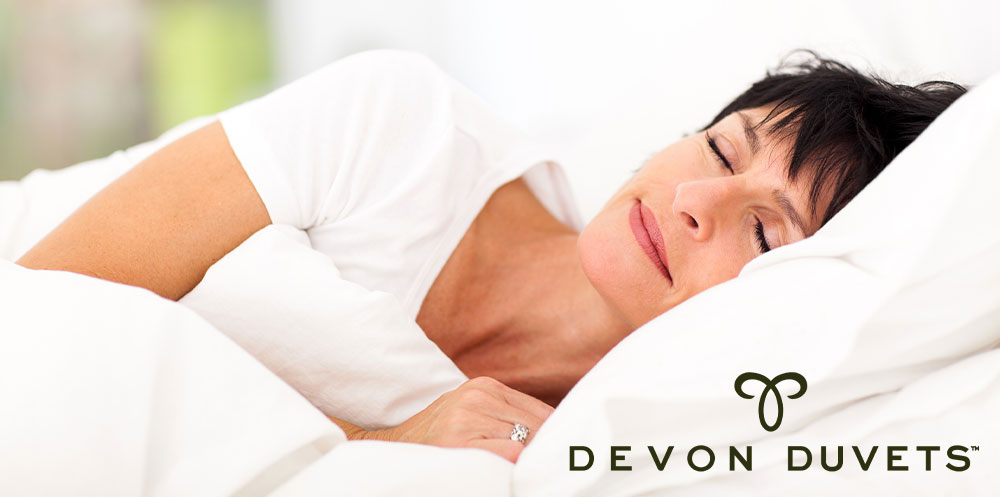Sleep tips for menopause

We’ve written a few blogs about menopause in the past, as it’s something that’s been uppermost in our minds for many years. In 2020, we worked with British Wool and our local branch of the Menopause Society to see if our British wool filled bedding could make a difference to the sleep quality of those struggling to sleep because of night sweats and temperature spikes. We were delighted when the results came in, with all those who tried our products saying that it had made a big difference to the quality of their sleep.
We’ll explain more about the reasons why this would be the case a bit further on in this blog, after our tips section - but, first, we’ve gathered some facts about sleep and menopause, which we hope you will find helpful.
What percentage of the population experiences sleep issues during menopause?
The Sleep Foundation found that around 12% of women experience sleep issues, but for women in their 40s and 50s this increases to 40%. For those experiencing menopause, this increases to around 50%.
What are the most common sleep problems during menopause?
These include hot flushes, insomnia, restless leg syndrome, sleep apnoea, together with an increase in anxiety, which can heighten sleep problems.
Why does menopause affect sleep?
In perimenopause and menopause there is a decline in the hormones Oestrogen and Progesterone. This affects the body’s internal clock (also known as the circadian rhythm) due to the impact on serotonin production. Oestrogen also helps with body temperature regulation and so as Oestrogen levels fall, people can experience higher body temperatures and lower quality of sleep.
Our top tips for better sleep during menopause (and after!)
- Follow a regular sleep schedule: Try to go to sleep and get up at the same time each day – even at the weekend.
- Avoid napping: Particularly in the late afternoon or evening as it may keep you awake at night.
- Develop a bedtime routine: Read a book, listen to relaxing music or soak in a warm bath. A warm bath at least 30 minutes before bedtime then allows for a ‘cool down’ period that will trigger your body into sleep mode.
- Avoid screen time before bed: This one applies to everyone, not just those going through menopause. We’ve mentioned this many times before but the lights from TVs, mobiles and devices can interfere with your sleep cycle and the release of the ‘sleep hormone’, Melatonin.
- Keep your bedroom at a comfortable temperature: The optimum bedroom temperature for sleep is around 16c – 18c degrees. Fresh air will also help, so open a window if you can (and it’s not freezing outside!) – even if just a little. Your bedroom should be a quiet haven of cosiness and calm.
- Exercise: One study, published in the National Library of Medicine, showed that around 30 – 45 minutes of moderate physical activity a day helped to ease menopausal symptoms. In those who took part, hot flushes reduced from 30.1% to 11.8%; sleep problems dropped by two thirds and joint discomfort from 52% to 4.4%.
- Avoid eating large meals close to bedtime and stop drinking caffeine after lunch: Our bodies slow down our digestion close to bedtime so if you eat late, your body has to work harder when it wants and needs to be moving to a restful state. Caffeine is a known stimulant and can block adenosine receptors in the brain – one of our sleep triggering chemicals. The caffeine’s stimulant properties can last about 8 hours, so that means avoiding caffeine after lunch, from 2pm.
- Avoid alcohol before bed: It may initially have sedative effects, but even a small amount of alcohol will disrupt the quality of your sleep – and can induce feelings of fatigue the following day.
- Use relaxation techniques: Relaxation is essential for our autonomic nervous system, which regulates our involuntary processes such as heart rate, blood pressure, respiration, and digestion. It also helps to stimulate parasympathetic nervous system (PNS) that supports repair and recovery. Yoga, mindfulness, and meditation are excellent ways to practice relaxation.
- Use bedding made from natural materials: Bedding made from synthetic fibres is not generally breathable, so will trap heat when you are already experiences hot flushes. Bedding that is made from 100% natural materials is breathable and will help with body temperature regulation whilst you sleep. In studies, soft filled bedding made with wool has been found to provide the best sleep experience.
Why is bedding made with wool considered to be an ideal choice for menopause?
Wool is a natural and sustainable fibre that has many wonderful properties that can help achieve a better night’s sleep. Natural wool is breathable and moisture wicking, working with your body and the ambient temperature in your bedroom to either retain or release heat as needed. You will still experience hot flushes, but the difference is that the wool will help to balance your core body temperature, so you don’t keep on waking up. Wool is also naturally resistant to dust mites and the build-up of micro bacteria, which makes is hygienic, and is also naturally fire retardant.
Why our wool bedding stands out from the crowd?
We only ever use fully traceable 100% British wool from farmers we know love and care for their flocks. Once gathered, our wool is washed and needled into soft layers, in traditional British mills and to our strict specifications, to ensure that no chemicals are used. This is because we want our wool to retain as many of its natural properties as possible and to be eco-friendly - which is better for you and our planet. We also only use 100% cotton fabric for making our casings, to ensure the wool inside can do its temperature regulating job efficiently. Each one of our duvets, toppers and pillows is individually handcrafted, step by step, by our professional seamstresses, in our own workshops in Devon. This ensures only the very highest standards are met in terms of the materials we use for our products and in the way we make them.
If you have any questions about our duvets, toppers or pillows, then please do contact the team for help and/or guidance about which product is likely to be best for your requirements.


